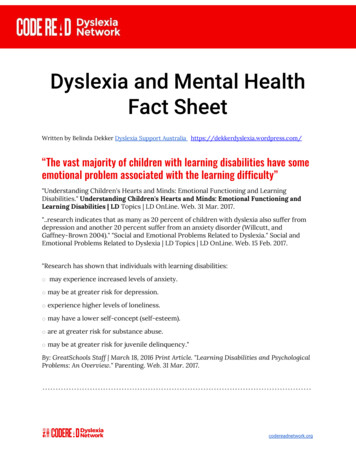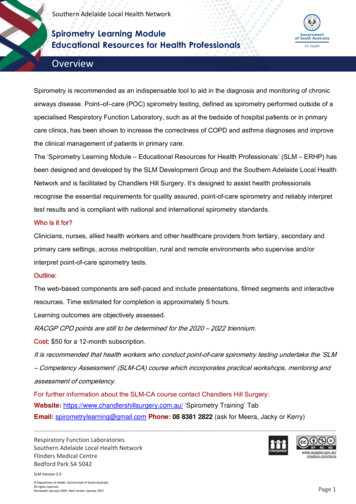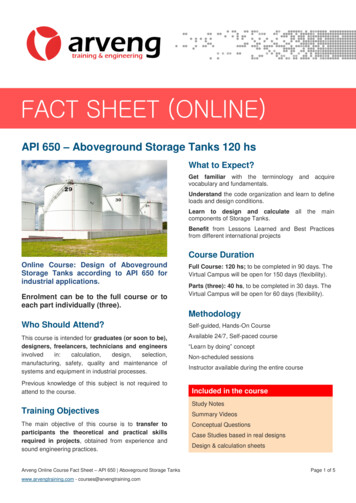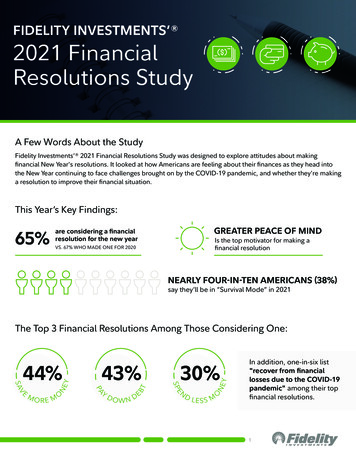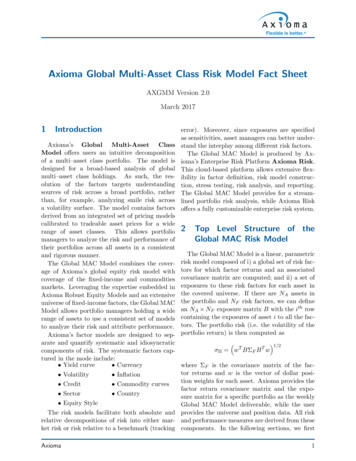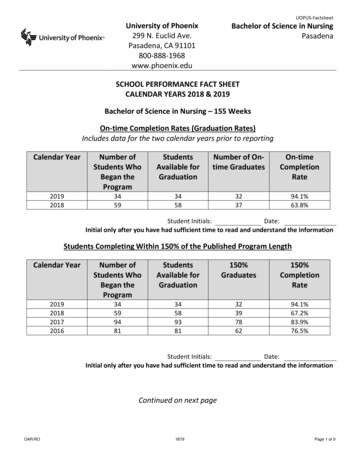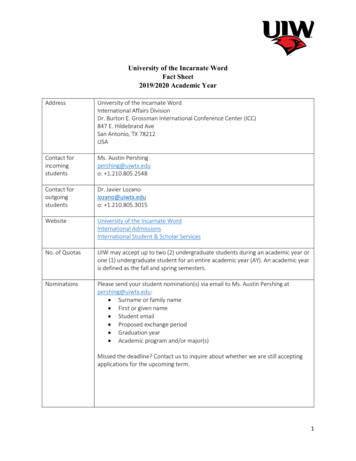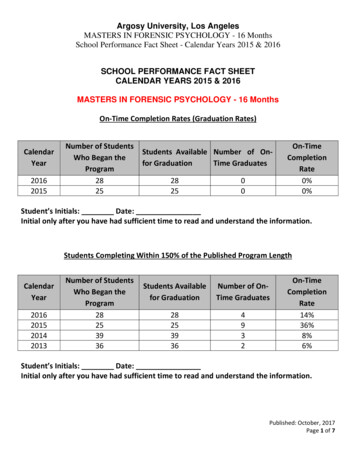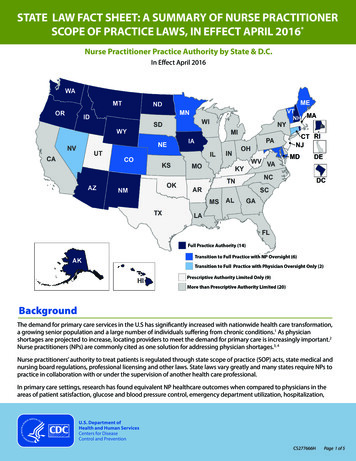
Transcription
STATE LAW FACT SHEET: A SUMMARY OF NURSE PRACTITIONERSCOPE OF PRACTICE LAWS, IN EFFECT APRIL 2016*Nurse Practitioner Practice Authority by State & D.C.In Effect April 2016BackgroundThe demand for primary care services in the U.S has significantly increased with nationwide health care transformation,a growing senior population and a large number of individuals suffering from chronic conditions.1 As physicianshortages are projected to increase, locating providers to meet the demand for primary care is increasingly important.2Nurse practitioners (NPs) are commonly cited as one solution for addressing physician shortages.3, 4Nurse practitioners’ authority to treat patients is regulated through state scope of practice (SOP) acts, state medical andnursing board regulations, professional licensing and other laws. State laws vary greatly and many states require NPs topractice in collaboration with or under the supervision of another health care professional.In primary care settings, research has found equivalent NP healthcare outcomes when compared to physicians in theareas of patient satisfaction, glucose and blood pressure control, emergency department utilization, hospitalization,CS277666HPage 1 of 5
duration of mechanical ventilation, length of stay, andmortality.5 Studies have also shown an association betweenthe level of state practice limitations placed on NPs andpatient access to primary care.1, 6, 7 States with laws thatlimit practice authority to a greater degree have lowerenrollment in advanced practice nurse (APRN) programs,a reduced number of practicing NPs and slower growthin new employment of NPs.1, 5 States that authorize NPsto practice independently have larger annual percentageincreases in patient seen by NPs.7 The increased use of NPshas also been positively correlated with healthcare costsavings.8, 9, 10A 2010 Institute of Medicine (IOM) report recommendedremoving SOP limitations for NPs to meet the increasingdemands for clinicians in primary care, acute, ambulatory,long-term, community and public health settings.11In order to achieve this goal, the IOM advised statelegislatures to amend SOP laws to conform to the NationalCouncil of State Boards of Nursing (NCSBN) Model NursingPractice Act.8 Under this model act, NPs are recognized aslicensed independent practitioners with the full authorityto independently carry out all medical acts consistentwith their education and training, including prescribingall forms of medication.12 Over 48 advanced practiceregistered nursing organizations and the AmericanAssociation of Retired Persons (AARP) have either endorsedor supported the Model Nursing Practice Act.13, 14When the IOM released its 2010 report, 14 states providedNPs full and independent practice authority.6 As of 2016,8 additional states have removed MD collaborative orsupervision practice requirements and granted full practiceauthority.15 This fact sheet summarizes the extent to whichstate NP SOP laws limited NP practice authority effectiveApril 1, 2016 and describes some of the common elementsof these state laws, and describes changes in state lawsince May 1, 2015.Data Collection and MethodsUsing the policy surveillance research method developedby the Center for Public Health Law Research, TempleUniversity,16 we systematically collected, reviewed andredundantly coded NP SOP laws (statutes, legislation,and regulations) in the 50 states and District of Columbia(collectively referred to as “states”) impacting NP practiceauthority in effect from May 1, 2015 through April 1, 2016.The team used the Westlaw search engine (ThomsonReuters, Eagan, Minnesota) to identify all relevant SOPlaws. Findings were cross-referenced with Internetlegislative and administrative code sites for each state.Search terms included “advanced practice nurs!,” “nursepractitioner!,” “‘nurse practitioner!’ /p scope,” and “nurse!/p scope.” One hundred percent of state law records wereredundantly coded and all divergences were resolved andrecoded to the agreed upon response. A supervisorTable 1. State Law Practice Classification Frequencies,in effect April 2016*Practice ClassificationFull Practice (ALL)# of States22Full Practice, No transition period14Full Practice w/transition period; authorizes NP/APRN collaboration6Full Practice w/transition period; authorizes physician only collaboration2Limited Practice (ALL)29Only prescribing authority limited9More than prescriptive authority limited20* Includes Washington, D.C.also performed quality control by downloading all codingdata into Microsoft Excel and examined the data for anymissing answers, incorrect citations or other issues. Priorto conducting a final analysis of the data, any missingresponses or incorrect citations were corrected by theresearchers.State LawsFull Practice AuthorityAs of April 1, 2016, all 50 states and the District of Columbiahave NP SOP laws (Table 1). Twenty-two (43%) states providefull practice authority to NPs. Of these, fourteen states(27.5%) provide full practice authority without a transitionperiod, six (11.8%) provide full practice after a transitionperiod with another NP or a physician (Colorado, Maryland,Maine, Minnesota, Nebraska and Vermont) and two (3.9%)provide full practice with a transition period which requirescollaboration with or supervision by a practicing physicianonly (Connecticut and Nevada). The length of transition topractice period varied across states, with some codified inhours (range: 1,000 to 2,400 hours) and others in months(range: 18 to 36 months).Limited Practice AuthorityTwenty-nine (57%) states limit NP practice authority. Ofthese, 9 (17.6%) states limit prescriptive authority only, while20 (39.2%) states limit NP’s authority to conduct more thanjust prescribing unless performed in collaboration with orunder the supervision of a physician.Page 2 of 5
States that limit prescriptive authority only requireNPs to collaborate with a physician when prescribingmedications, including when prescribing all legend drugsor only for controlled substances. States that limit morethan prescriptive authority require NPs to enter into acollaborative or supervisory agreement with a physicianto perform other activities that are explicitly codifiedin state law, including: making diagnoses, performingexams, ordering tests, prescribing and administeringmedications, initiating/managing patient treatment,making referrals, counseling patients, and/or interpretingpatient medical information.Recent State Law ChangesBetween May 1, 2015 and April 1, 2016, three statesmade changes to their NP SOP laws. Colorado reducedthe required transition to practice hours from 1,800to 1,000 hours. Maryland and Nebraska moved fromrequiring collaboration with a physician for all activitiesto requiring a transition to full practice period in whichan NP may collaborate with another NP. For more mapsand tables on state NP SOP laws please see the NursePractitioner Scope of Practice Laws dataset page atlawatlas.org.17ImplicationsDemand for timely access to primary care is projectedto continue to increase.18 Removing NP SOP practicelimitations has been shown to increase patient access toprimary care.1, 6, 7 Three states recently expanded NP SOP,while more than half the states continue to require NPs topractice in collaboration with or under the supervision ofa physician in order to prescribe medication or conductother clinical activities.For those states that limit NP practice authority, fullor incremental reductions in existing requirementscould expand access to primary care services. Furtherresearch on NP SOP laws, health care access and patientcare outcomes could provide necessary contextualinformation to inform future decision making. In an eraof impending physician shortages and increasing patientneed, more information is necessary to explore feasible,effective methods for ensuring accessible, affordable,high quality health care.References1. Reagan, P. B., & Salsberry, P. J. (2013). The effects of state-levelscope-of-practice regulations on the number and growth ofnurse practitioners. Nurse Outlook, 61(6), 392-399. doi: 10.1016/j.outlook.2013.04.007.2. Pearson, L. (2008). The Pearson Report: A National Overview of NursingPractitioner Legislation and Healthcare Issues. The American Journalfor Nurse Practitioners, 12(3), 3-803. Auerbach, D. I., Chen, P. G., Friedberg, M. W., Reid, R., Lau, C., Buerhause,P. I., . Mehrota, A. (2013). Nurse-managed health centers and patientcentered medical homes could mitigate expected primary carephysician shortage. Health Affairs, 32(11), 1933e1941.4. Robert Wood Johnson Foundation. (2013). Improving patient access tohigh quality care. http://www.rwjf. tient-accessto-high-quality-care.html.5. Newhouse RP, Stanik-Hutt J, White KM, Johantgen M, Bass EB, ZangaroG, et al. Advanced practice nurse outcomes 1990–2008: a systematicreview. Nurs Econ. 2011;29(5): 230–50.6. Kalist, D., & Spurr, S. J. (2004). The effect of state laws on the supply ofadvanced practice nurses. International Journal of Health Care Financeand Economics, 4, 271-281.7. Kuo, Y. F., Loresto, F. L., Jr., Rounds, L. R., & Goodwin, J. S. (2013). Stateswith the least restrictive regulations experienced the largest increasein patients seen by nurse practitioners. Health Aff (Millwood), 32(7),1236-1243. doi: 10.1377/hlthaff.2013.00728. Hooker, R. S., & Muchow, A. N. (2015). Modifying State Laws for NursePractitioners and Physician Assistants Can Reduce Cost Of MedicalServices. Nurs Econ, 33(2), 88-94.9. Hansen-Turton, T. (2005). The nurse-managed health center safety net:A policy solution to reducing health disparities. The Nursing Clinics ofNorth America, 40(4), 729.10. Hing, E., Hooker, R.S., & Ashman, J. J. (2010). Primary health care incommunity health centers and comparison with office-based practice.Journal of Community Health, 36(3), 406- 413.11. Institute of Medicine. (2010). The future of nursing: Leading change,advancing health. http://books.nap.edu/openbook.php?recordid 12956&page R1. Accessed August 25, 201612. NCSBN Model Act. National Council of State Boards of Nursing.Copyright 2012 https://www.ncsbn.org/14 Model Act 0914.pdf.Accessed August 25, 201613. NCSBN Consensus Model for APRN Regulation: Licensure,Accreditation, Certification & Education. July 7, 2008 https://www.ncsbn.org/Consensus Model for APRN Regulation July 2008.pdf.Accessed August 25, 201614. AARP Commends Passage of Bills Pertaining to Scope of Nursing.August 31, 2005 ate-bills-57-and-101/. Accessed August 25, 201615. State Practice Environment. American Association of NursePractitioners. egislation/state-practice-environment. Accessed August 25, 201616. Anderson, Evan D. and Tremper, Charles and Thomas, Sue andWagenaar, Alexander C, Measuring Statutory Law and Regulations forEmpirical Research. Public Health Law Research, February 28, 2012.http://ssrn.com/abstract 2021191. Accessed August 25, 201617. Nurse Practitioner Scope of Practice Laws. (2016, April 1). LawAtlas:The Policy Surveillance Portal. pe-of-practice-146040216. Accessed August 25, 201618. U.S. Department of Health and Human Services, Health Resources andServices Administration, National Center for Health Workforce Analysis.Projecting the Supply and Demand for Primary Care PractitionersThrough 2020. Rockville, Maryland: U.S. Department of Health andHuman Services, 2013. /projectingprimarycare.pdf. Accessed August 25, 2016* This fact sheet presents a summary of laws in effect as of April 1, 2016 and is not intended to promote any particular legislative, regulatory or other action. Learn more about State LawFact Sheets at www.cdc.gov/dhdsp/pubs/policy resources.htm.Page 3 of 5
Table 2: Nurse Practitioner Full or Limited Practice Authority Laws, in effect May 1, 2015- April 1, 2016StatePractice classificationStatutory & Regulatory CitationsAlabamaMore than prescriptive authority limitedALA. CODE § 20-2-250 (2014); ALA. CODE § 34-21-81 (2001); ALA. CODE § 34-21-86 (1996); ALA. ADMIN. CODE r. 540-X-8-.08 (2015);ALA. ADMIN. CODE r. 540-X-8-.10 (2008); ALA. ADMIN. CODE r. 540-X-8-.11 (2003); ALA. ADMIN. CODE r. 610-X-5-.05 (2015); ALA.ADMIN. CODE r. 610-X-5-.08 (2015); ALA. ADMIN. CODE r. 610-X-5-.09 (2015); ALA. ADMIN. CODE r. 610-X-5-.11 (2015); ALA. ADMIN.CODE r. 610-X-5-.12 (2015); ALA. ADMIN. CODE r. 610-X-6-.01 (2009)AlaskaFull Practice, No transition periodALASKA STAT. § 08.68.850 (2002); ALASKA ADMIN. CODE tit. 12, § 44.380 (2014); ALASKA ADMIN. CODE tit. 12, § 44.430(1980); ALASKA ADMIN. CODE tit. 12, § 44.440 (2014)ArizonaFull Practice, No transition periodARIZ. REV. STAT. § 32-1601 (2012); ARIZ. ADMIN. CODE § R4-19-508 (2013); ARIZ. ADMIN. CODE § R4-19-511 (2013);ARIZ. ADMIN. CODE § R4-19-512 (2013)ArkansasOnly prescriptive authority limitedARK. CODE ANN. § 17-87-102 (2015); ARK. CODE ANN. § 17-87-310 (2015); 067-00-1 ARK. CODE R. § 2 (2013); 067-00-3ARK. CODE R. § 1 (2013); 067-00-4 ARK. CODE R. § 1 (2013); 067-00-4 ARK. CODE R. § 8 (2013)CaliforniaMore than prescriptive authority limitedCAL. BUS. & PROF. CODE § 2725 (West 2004); CAL. BUS. & PROF. CODE § 2725.5 (West 2004); CAL. BUS. & PROF. CODE §2835.7 (West 2010); CAL. BUS. & PROF. CODE § 2836.1 (West 2013); CAL. BUS. & PROF. CODE § 2836.2 (West 2004)Full Practice w/transition period; authorizes NP/APRNcollaboration. Transition to Practice Period: 1,000 Hours(Effective 9/1/2016)Full Practice w/transition period; authorizes physician onlycollaboration. Transition to Practice Period: 2,000 Hours and3 YearsCOLO. REV. STAT. § 12-38-103 (2015); COLO. REV. STAT. § 12-38-111.6 (2015); 716 COLO. CODE REGS. § 716-1:XVI-1(2016); 716 COLO. CODE REGS. § 716-1:XVI-4 (2016); 2505 COLO. CODE REGS. § 2505-10:8.740 (2016)*ColoradoConnecticutDelawareMore than prescriptive authority limitedCONN. GEN. STAT. ANN. § 20-87A (West 2015); CONN. GEN. STAT. ANN. § 20-94A (West 2012)DEL. CODE ANN. tit. 24, § 1902 (2016); 24 DEL. CODE REGS. § 1700-11.0 (2013); 24 DEL. CODE REGS. § 1900-8.4 (2015);24 DEL. CODE REGS. § 1900-8.7 (2015); 24 DEL. CODE REGS. § 1900-8.14 (2015); 24 DEL. CODE REGS. § 1900-8.15 (2015);24 DEL. CODE REGS. § 1900-8.18 (2015)District of Columbia Full Practice, No transition periodD.C. CODE § 3-1201.02 (2016); D.C. CODE § 3-1206.01 (1995); D.C. CODE § 3-1206.03 (1995); D.C. CODE § 3-1206.04(1995); D.C. Mun. Regs. Tit. 17, § 5499 (2004); D.C. Mun. Regs. Tit. 17, § 5909 (2002)FloridaMore than prescriptive authority limitedFLA. STAT. § 464.003 (2014); FLA. ADMIN. CODE ANN. r. 59A-3.065 (2014); FLA. ADMIN. CODE ANN. r. 64B8-35.002(2013); FLA. ADMIN. CODE ANN. r. 64B9-14.001 (1996)GeorgiaMore than prescriptive authority limitedGA. CODE ANN. § 43-26-3 (2012)GA. CODE ANN. § 43-34-25 (2015); GA. COMP. R. & REGS. 410-11-.01 (2015); GA. COMP.R. & REGS. 410-11-.03 (2015); GA. COMP. R. & REGS. 410-12-.01 (1997); GA. COMP. R. & REGS. 410-12-.03 (2008); GA.COMP. R. & REGS. 410-13-.01 (2013) (repealed 2015)HawaiiFull Practice, No transition periodHAW. REV. STAT. § 457-2 (2015); HAW. REV. STAT. § 457-2.7 (2014); HAW. REV. STAT. § 457-8.6 (2011); HAW. CODE R. §16-89-2 (2013); HAW. CODE R. § 16-89-81 (2013)IdahoFull Practice, No transition periodIDAHO CODE § 54-1402 (2013); IDAHO ADMIN. CODE r. 23.01.01.271 (2013); IDAHO ADMIN. CODE r. 23.01.01.280 (2013);IDAHO ADMIN. CODE r. 23.01.01.315 (2013)IllinoisMore than prescriptive authority limitedIndianaMore than prescriptive authority limitedIowaFull Practice, No transition periodIOWA CODE § 152.1 (2015); IOWA ADMIN. CODE r. 655-6.1.152 (2003); IOWA ADMIN. CODE r. 655-6.7.152 (2011); IOWAADMIN. CODE r. 655-7.1.152 (2009); IOWA ADMIN. CODE r. 655-7.2.152 (2009)KansasMore than prescriptive authority limitedKAN. STAT. ANN. § 65-1113 (2012); KAN. STAT. ANN. § 65-1130 (2012); KAN. ADMIN. REGS. § 60-11-101 (2012); KAN.ADMIN. REGS. § 60-11-102 (2012); KAN. ADMIN. REGS. § 60-11-104 (2012); KAN. ADMIN. REGS. § 60-11-104A (2012)KentuckyOnly prescriptive authority limitedKY. REV. STAT. ANN. § 341.011 (West 2015); KY. REV. STAT. ANN. § 341.042 (West 2015); KY. REV. STAT. ANN. § 341.195(West 2015); KY. REV. STAT. ANN. § 341.196 (West 2015); 201 KY. ADMIN. REGS. 20:057 (2015)LouisianaMore than prescriptive authority limitedLA. REV. STAT. ANN. § 37:913 (2003); LA. ADMIN. CODE tit. 46, § 4503 (2014); LA. ADMIN. CODE tit. 46, § 4505 (2014); LA.ADMIN. CODE tit. 46, § 4513 (2014)Full Practice w/transition period; authorizes NP/APRNcollaboration. Transition to Practice Period: 24 months (2years)Full Practice w/transition period; authorizes NP/APRNcollaboration* (Effective 10/1/2015) Transition to PracticePeriod: 18 months (Effective 10/1/2015) *More thanprescriptive authority limited (Repealed 9/31/2015)ME. REV. STAT. ANN. tit. 32, § 2102 (2015); 02-380-8 ME. CODE R. § 1 (Weil 2010); 02-380-8 ME. CODE R. § 2 (Weil 2010);02-380-8 ME. CODE R. § 6 (Weil 2010)MassachusettsOnly prescriptive authority limitedMASS. GEN. LAWS ANN. ch. 112, § 80B (West 2012); 243 MASS. CODE REGS. 2.10 (2012); 244 MASS. CODE REGS. 3.01(1994); 244 MASS. CODE REGS. 4.02 (2014); 244 MASS. CODE REGS. 4.03 (2014); 244 MASS. CODE REGS. 4.07 (2014)MichiganMore than prescriptive authority limitedMICH. COMP. LAWS § 333.17021 (1978); MICH. COMP. LAWS § 333.17212 (1996)MinnesotaFull Practice w/transition period; authorizes NP/APRNcollaboration. Transition to Practice Period: 2,080 hoursMINN. STAT. § 148.171 (2015); MINN. STAT. § 148.235 (2015)MississippiMore than prescriptive authority limitedMISS. CODE ANN. § 73-15-5 (2010); MISS. CODE ANN. § 73-15-20 (2010); 30-18-2840 MISS. CODE R. § 2.3 (2011); 3018-2840 MISS. CODE R. § 2.4 (2011)MissouriMore than prescriptive authority limitedMO. REV. STAT. § 335.016 (2009); MO. CODE REGS. ANN. tit. 20, § 2200-4.100 (2010); MO. CODE REGS. ANN. tit. 20, §2200-4.100 (2010)Maine*Maryland*Denotes state that has changed practice classification during study period225 ILL. COMP. STAT. 65/50-10 (2015); 225 ILL. COMP. STAT. 65/65-30 (2007); 225 ILL. COMP. STAT. 65/65-35 (2015); 225ILL. COMP. STAT. 65/65-40 (2013); 225 ILL. COMP. STAT. 65/65-45 (2015); ILL. ADMIN. CODE tit. 68, § 1300.410 (2010);ILL. ADMIN. CODE tit. 68, § 1300.420 (2010); ILL. ADMIN. CODE tit. 68, § 1300.430 (2015); ILL. ADMIN. CODE tit. 68, §1300.440 (2010)IND. CODE ANN. § 25-23-1-1 (West 2014); IND. CODE ANN. § 25-23-1-19.4 (West 2014); IND. CODE ANN. § 25-23-1-19.5(West 2014); 848 IND. ADMIN. CODE 2-1-2 (2013); 848 IND. ADMIN. CODE 4-1-3 (2013); 848 IND. ADMIN. CODE 4-1-4(2013); 848 IND. ADMIN. CODE 5-1-1 (2010); 848 IND. ADMIN. CODE 5-2-1 (2013)MD. CODE ANN., HEALTH OCC. § 8-101 (West 2015); MD. CODE ANN., HEALTH OCC. § 8-302 (West 2015); MD. CODE ANN.,HEALTH OCC. § 8-508 (West 2010); MD. CODE REGS. 10.27.07.01 (2015); MD. CODE REGS. 10.27.07.02 (2015)Page 4 of 5
Table 2: Nurse Practitioner Full or Limited Practice Authority Laws, in effect May 1, 2015- April 1, 2016StatePractice classificationStatutory & Regulatory CitationsMontanaFull Practice, No transition periodMONT. CODE ANN. § 37-8-102 (2011); MONT. ADMIN. R. 24.156.1601 (2006); MONT. ADMIN. R. 24.159.301 (2013);MONT. ADMIN. R. 24.159.1406 (2013); MONT. ADMIN. R. 24.159.1463 (2013)Full Practice w/transition period; authorizes NP/APRNcollaboration* (Effective 8/30/2015) Transition to PracticePeriod: 2,000 hours (Effective 8/30/2015) *More thanprescriptive authority limited (Repealed 8/29/2015)Full Practice w/transition period; authorizes physician onlycollaboration. Transition to Practice Period: 2,000 hours OR2 yearsNEV. REV. STAT. § 632.012 (2013); NEV. REV. STAT. § 632.018 (2013); NEV. REV. STAT. § 632.237 (2015); NEV. ADMIN. CODE§ 630.490 (2003); NEV. ADMIN. CODE § 632.061 (1998)New HampshireFull Practice, No transition periodN.H. REV. STAT. ANN. § 326-B:2 (2015); N.H. REV. STAT. ANN. § 326-B:11 (2009)New JerseyOnly prescriptive authority limitedN.J. REV. STAT. § 45:11-23 (2004); N.J. REV. STAT. § 45:11-49 (2015); N.J. ADMIN. CODE § 13:37-7.9 (2008); N.J. ADMIN.CODE § 13:37-8.1 (2011)New MexicoFull Practice, No transition periodN.M. STAT. § 61-3-3 (2005); N.M. STAT. § 61-3-23.2 (2014)New YorkMore than prescriptive authority limitedN.Y. EDUCATION LAW § 6901 (McKinney 1972); N.Y. EDUCATION LAW § 6902 (McKinney 2015); N.Y. COMP. CODES R ®S. tit. 18, § 505.32 (1995); N.Y. COMP. CODES R & REGS. tit. 18, § 505.8 (2008)North CarolinaMore than prescriptive authority limited21 N.C. ADMIN. CODE 36.0801 (2012); 21 N.C. ADMIN. CODE 36.0802 (2012); 21 N.C. ADMIN. CODE 36.0809 (2012); 21N.C. ADMIN. CODE 36.0810 (2010)North DakotaFull Practice, No transition periodN.D. CENT. CODE § 43-12.1-02 (2013); N.D. ADMIN. CODE 54-05-03.1-03.1 (2014); N.D. ADMIN. CODE 54-05-03.1-03.2(2014); N.D. ADMIN. CODE 54-05-03.1-09 (2014); N.D. ADMIN. CODE 54-05-03.1-10 (2014)OhioMore than prescriptive authority limitedOHIO REV. CODE ANN. § 4723.1 (West 2015); OHIO REV. CODE ANN. § 4723.43 (West 2013); OHIO REV. CODE ANN. §4723.481 (West 2015); OHIO ADMIN. CODE 4723-8-01 (2016); OHIO ADMIN. CODE 4723-8-04 (2016); OHIO ADMIN. CODE4723-9-09 (2016)OklahomaOnly prescriptive authority limitedOKLA. STAT. tit. 59, § 567.3A (2011); OKLA. ADMIN. CODE § 485:10-1-2 (2014); OKLA. ADMIN. CODE § 485:10-15-6(2015)OregonFull Practice, No transition periodOR. REV. STAT. § 678.010 (2001); OR. REV. STAT. § 678.375 (2013); OR. REV. STAT. § 678.390 (2013); OR. ADMIN. R. 851050-0000 (2015); OR. ADMIN. R. 851-050-0005 (2014); OR. ADMIN. R. 851-056-0000 (2015); OR. ADMIN. R. 851-0560004 (2015)PennsylvaniaMore than prescriptive authority limited63 PA. CONS. STAT. ANN. § 212 (2007); 63 PA. CONS. STAT. ANN. § 218.2 (2007); 63 PA. CONS. STAT. ANN. § 218.3 (2003);49 PA. CODE § 21.251 (2009); 49 PA. CODE § 21-283 (2009); 49 PA. CODE § 21-284 (2009); 49 PA. CODE § 21.284B (2009);49 PA. CODE § 21-285 (2009)Rhode IslandFull Practice, No transition periodR.I. GEN. LAWS § 5-34-3 (2014); R.I. GEN. LAWS § 5-34-44 (2014); R.I. GEN. LAWS § 5-34-49 (2013); 31-5-28 R.I. CODER. § 1.0 (2014)South CarolinaMore than prescriptive authority limitedS.C. CODE ANN. § 40-33-20 (2005); S.C. CODE ANN. § 40-33-34 (2008); S.C. CODE ANN. REGS. 81-110 (2012)South DakotaMore than prescriptive authority limitedS.D. CODIFIED LAWS § 36-9A-1 (2014); S.D. CODIFIED LAWS § 36-9A-12 (2006); S.D. CODIFIED LAWS § 36-9A-13.1 (1999);S.D. CODIFIED LAWS § 36-9A-15 (1999); S.D. CODIFIED LAWS § 36-9A-17 (1999); S.D. ADMIN. R. 20:62:03:03 (2008); S.D.ADMIN. R. 20:62:03:08 (1999)TennesseeOnly prescriptive authority limitedTENN. CODE ANN. § 63-7-123 (2013); TENN. CODE ANN. § 63-7-126 (2013); TENN. COMP. R. & REGS. 1000-04-.02 (2004);TENN. COMP. R. & REGS. 1000-04-.09 (2005)TexasOnly prescriptive authority limited22 TEX. ADMIN. CODE § 217.1 (2014); 22 TEX. ADMIN. CODE § 217.11 (2007); 22 TEX. ADMIN. CODE § 221.1 (2010); 22TEX. ADMIN. CODE § 221.12 (2001); 22 TEX. ADMIN. CODE § 221.13 (2001); 22 TEX. ADMIN. CODE § 222.1 (2013); 22 TEX.ADMIN. CODE § 222.4 (2013); 22 TEX. ADMIN. CODE § 224.4 (2003)UtahOnly prescriptive authority limitedUTAH CODE ANN. § 58-31b-102 (2016); UTAH ADMIN. CODE r. R156-31b-102 (2014); UTAH ADMIN. CODE r. R156-31b703b (2014)VermontFull Practice w/transition period; authorizes NP/APRNcollaboration. Transition to Practice Period: 2,400 hours and24 months (2 years)VT. STAT. ANN. tit. 26, § 1572 (2015); VT. STAT. ANN. tit. 26, § 1612 (2015); VT. STAT. ANN. tit. 26, § 1613 (2011); 20-41400 VT. CODE R. § 1400:9.17 (2015); 20-4-1100 VT. CODE R. § 1100:15 (2011) (Repealed 2015)VirginiaMore than prescriptive authority limitedVA. CODE ANN. § 54.1-2957 (2016); VA. CODE ANN. § 54.1-3000 (2016); 18 VA. ADMIN. CODE § 90-30-120 (2014); 18 VA.ADMIN. CODE § 90-40-40 (2008); 18 VA. ADMIN. CODE § 90-40-90 (2008); 18 VA. ADMIN. CODE § 90-40-100 (2015)WashingtonFull Practice, No transition periodWASH. ADMIN. CODE § 246-840-010 (2013); WASH. ADMIN. CODE § 246-840-300 (2009); WASH. ADMIN. CODE § 246840-400 (2009)West VirginiaOnly prescriptive authority limitedW. VA. CODE § 30-7-1 (2016); W. VA. CODE § 30-7-15a (2016); W. VA. CODE R. § 19-7-2 (2013); W. VA. CODE R. § 19-7-3(2013)WisconsinMore than prescriptive authority limitedWIS. STAT. § 441.16 (2014); WIS. ADMIN CODE § 8.02 (2001); WIS. ADMIN CODE § 8.03 (2001); WIS. ADMIN CODE § 8.10(2000)WyomingFull Practice, No transition periodWYO. STAT. ANN. § 33-21-120 (2005); HLTH MDCD WYO. CODE R. § 7 (2006)*NebraskaNevada*Denotes state that has changed practice classification during study periodNEB. REV. STAT. § 38-2310 (2015); NEB. REV. STAT. § 38-2312 (2008); NEB. REV. STAT. § 38-2314.01 (2015); NEB. REV.STAT. § 38-2315 (2015); NEB. REV. STAT. § 38-2322 (2015)Page 5 of 5
A 2010 Institute of Medicine (IOM) report recommended removing SOP limitations for NPs to meet the increasing demands for clinicians in primary care, acute, ambulatory, long-term, community and public health settings.11 In order to achieve this goal, the IOM advised state

